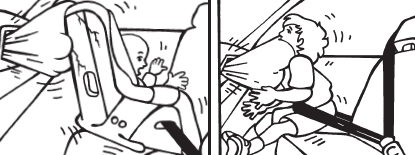An air bag can save your life. However, air bags and young children are a dangerous combination.
Front airbags are installed in all new cars. When used with seat belts, airbags work well to protect teenagers and adults; however, airbags can be very dangerous to children, particularly to those riding in rear-facing seats and to preschoolers and young school-aged children who are not properly restrained.
If your vehicle has a front passenger airbag, infants in rear-facing seats must ride in the back seat. Even in a relatively low-speed crash, the airbag can inflate, strike the car seat, and cause serious brain injury and death.
Vehicles with no back seat or a back seat that is not made for passengers are not the best choice for traveling with small children; however, the airbag can be turned off in some of these vehicles if the front seat is needed for a child passenger. See your vehicle owner’s manual for more information.
Side airbags are available in most new cars. Side airbags improve safety for adults in side-impact crashes. Read your vehicle owner’s manual for more information about the airbags in your vehicle. Read your car seat instructions and the vehicle owner’s manual for guidance on placing the seat next to a side airbag.
The following information will help keep you and your children safe:

What parents can do:
Eliminate potential risks of air bags to children by buckling them in the back seat for every ride.
Plan ahead so that you do not have to drive with more children than can be safely restrained in the back seat.
For most families, installation of air bag on/off switches is not necessary. Air bags that are turned off provide no protection to older children, teens, parents, or other adults riding in the front seat.
Air bag on/off switches should only be used if your child has special health care needs for which your pediatrician recommends constant observation during travel and no other adult is available to ride in the back seat with your child.
If no other arrangement is possible and an older child must ride in the front seat, move the vehicle seat back as far as it can go, away from the air bag. Be sure the child is restrained properly. Keep in mind that your child may still be at risk for injuries from the air bag. The back seat is the safest place for children to ride.